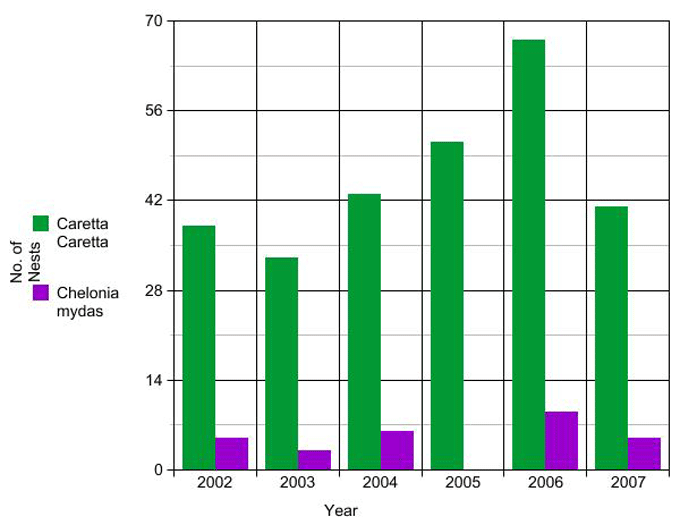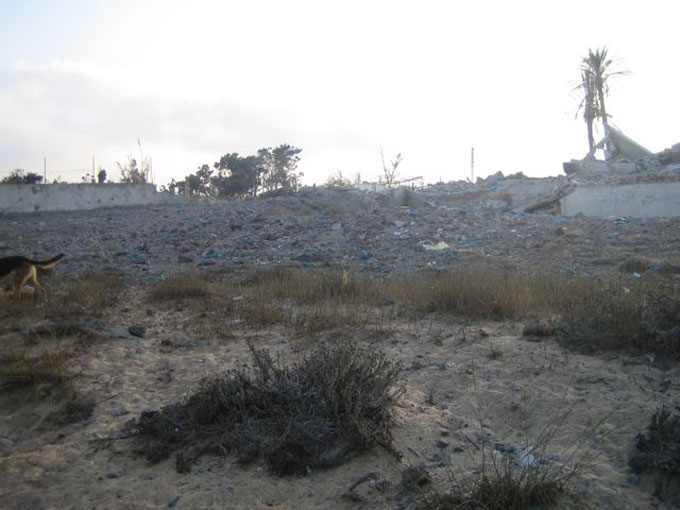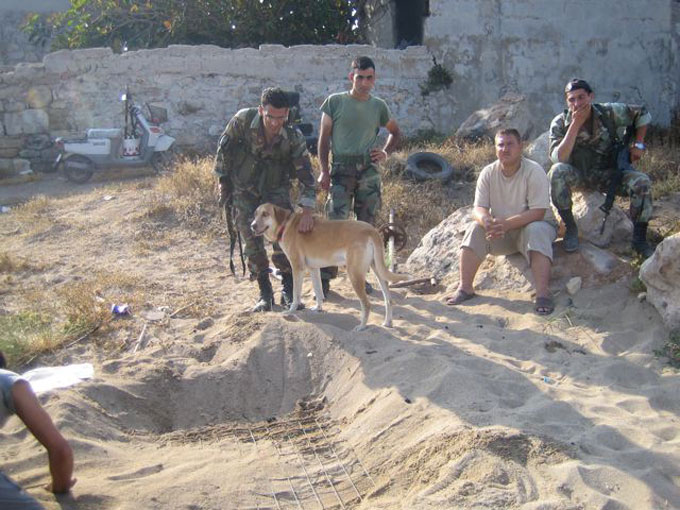Mona Khalil¹, Habiba Syed¹ and Monica Aureggi²
¹PO Box 19, Sour, Lebanon. Email: monahabiba{at}gmail.com
²NAUCRATES, Colle Tenne, 04010 Cori (LT), Italy. Email: naucrates12{at}tiscali.it
Introduction
According to the first survey of the entire Lebanese coast to assess sea turtle nesting and potential nesting sites, conducted in 2001 (Demirayak et al., 2002), and another survey in 2004 (Kasparek, 2004), nesting in the north is sparse and scattered over several developed beaches, while more important nesting sites of national and regional significance are found in the south (Aureggi et al., 2005).
Southern Lebanon has been under considerable socio-economic strain since the end of the Israeli occupation in 2000 and was badly affected by the war of 2006. This area remains undeveloped and several nesting sites have been identified. Three of these, located along a 20km stretch of coast near the city of Tyre, are important for both Mediterranean nesting species in south Lebanon. The sites are Tyre Coast Nature Reserve, El Mansouri and El Koliala, and El Aabbassiye beach.
This paper refers to the southernmost beach, called El Mansouri and El Koliala, which lies about 20km from the border with Israel. It is 1.4km long, with small sand dunes covered by sparse dune vegetation. The paper describes how the war affected the sea turtle population and its nesting habitat. It contains no political message, the intention being only to explain the impact of such an event on the sea turtle nesting population and on the monitoring team in charge of a project to conserve it. The paper focuses on sea turtles, not on the wider human impact of the war.
Sea turtle monitoring programme
The beach has been regularly monitored by a Lebanese team every year since 2001. This effort has documented the highest density of loggerhead (Caretta caretta) and green turtle (Chelonia mydas) nests in the country. The available data indicate that this beach is the biggest contributor to the overall number of nests, but it should be noted that it is also the only beach where a yearly survey has been regularly conducted over eight years (Aureggi et al., 2005).
Data gathered from daily surveys over the entire nesting season and from sporadic surveys or visits during the nesting season show that the combined nesting effort at all Lebanon’s nesting beaches falls within the general Mediterranean range of 21 to 100 loggerhead nests per season found by Margaritoulis et al. (2003). The total number of loggerhead nests per year varied from a minimum of 33 to a maximum of 67. The 6-year trend reflects the natural life cycle of this animal and of the whole Mediterranean region (Table 1).

Table 1. Total number of loggerhead and green turtle nests per year at El Mansouri and El Koliala beach.
Nests are not evenly distributed along the 1.4km of beach, but are concentrated in two main areas, where nests sometimes even overlap. The total number of green turtle nests varied from zero to nine nests per season. The low number indicates that the nesting environment is probably more suitable for loggerheads. The beach is narrow with small dunes.
Seaturtle monitoring season 2006
As in every year since 2001, the monitoring season in 2006 began at the end of May. From May 24, two people patrolled the beach early every morning, identifying turtle tracks and nests. Nests considered threatened by natural inundation of the sea or agricultural run-off, or because they were not deep enough, were relocated to a safer place higher up the beach. Nests were all protected by placing a 1 square metre cage over them to foil predators.
The war began on July 13. At first, monitoring continued every morning, even though the team had been warned to leave the house. After about two weeks of hostilities, the bombing became too dangerous. One morning, while walking near the shoreline, the team saw a bomb fall on the village at the end of the beach. It was time to leave.
The war had a significant social, economic and environmental impact on Lebanon, apart from the losses in civilian lives, houses and infrastructure. Israeli bombing of fuel tanks at the Jiyeh power station, 30km south of Beirut, spilled about 15,000 tonnes of heavy fuel oil into the Mediterranean Sea. Sea currents meant the disaster affected the coastline north of Jiyeh, while El Mansouri and El Koliala beach were not affected. Two years after the conflict, teams were still at work cleaning up oil waste.
The war stopped on August 14. The team returned to their home in the south a few days later to find the house badly damaged by an Israeli shell, which had punched a hole in one wall and scattered debris all over. An entire room had to be rebuilt, among other repairs. Monitoring resumed as soon as possible. It was immediately clear that the nesting habitat had been damaged by bombs. On the other hand, the fact that no fishing went on during the war and nobody used the beach created an undisturbed environment probably suitable for nesting.
Impact of the war on the nesting beach
El Mansouri and El Koliala beaches are in an agricultural area. The dune system is interrupted to the rear by a wall at the boundary of private farmland. Some of the bomb craters on the beach were the size of a green turtle body pit, some much bigger. We collected the shrapnel. Luckily we did not have to deal with cluster bombs that endangered life elsewhere in south Lebanon. Bombs had destroyed a large summer house near the northern end of the beach, scattering shrapnel and a store of blue plastic bags that are used to cover banana trees in winter. As shown in the picture (Fig. 1) pieces of blue plastic were everywhere on the beach.

Fig. 1. Bomb devastation and shredded plastic on the beach.
The war and its aftermath also had indirect effects on the sea turtle nesting population. Soon after the ceasefire, the Lebanese army was deployed to the south, including about 100 soldiers based near the northern end of the beach, in an area where we had recorded the highest annual concentration of sea turtle nests. Soldiers brought puppies and left them on the beach. They took hundreds of bags of sand from the nesting area to build a defence wall. They also extracted sand and destroyed dune vegetation to make a football pitch. They fished from the beach with a gill net and used it as a rubbish dump. Some of their sewage flowed straight into the sea. At the southern end of the beach a refreshment kiosk was set up over a nesting area. Metal screens were carelessly removed from nearby nests. People used the kiosk, mainly in the evening, for about a month until the police removed it as an illegal activity.
Having soldiers around the beach during our daily monitoring was an opportunity to raise their awareness (Fig. 2). They were mainly from Tripoli, in north Lebanon, where it is generally thought that turtles damage fishing nets and are often killed for this reason.

Fig. 2. Soldiers watching the placement of nest protection mesh.
Fishing activities
Impoverished locals often use unsustainable fishing methods, including poison and dynamite. Dynamite fishing increased after the 2006 war and has become more popular than before the conflict. Coastguards were seen driving on the beach. Since it is small and narrow, this could become a problem during nest incubation.
Nest Predators
Before the war, dogs were the main predators of nests, but metal screens provided efficient protection for the eggs. The conflict brought foxes, probably driven from nearby hills by intense bombing. They managed to open a few nests by digging from the top or side of the screen. They became more proficient at this in the following season (2007) when they raided 17% of loggerhead nests. In 2008 new screens were introduced, made of heavier metal reinforced with hooks. Foxes still managed to raid 11% of nests, which they attacked through the mesh.
Conclusions and recommendations
Southern Lebanon has been under considerable socio-economic strain for years and most people are not environmentally conscious. In a country where animals and the environment are far from top priorities, the monitoring programme at El Mansouri and El Koliala is unique. Two years after the war, it continues to protect all laid nests.
- Raising local awareness will continue, especially among the young.
- Fishing activities, especially the use of dynamite, need attention from local and national authorities. An alternative sustainable way of fishing must be introduced.
- Rubbish on the beach, some washed up and some left by people, should be reduced by awareness campaigns and improved municipal services.
- The beach has still not been declared a protected area at a national level. This must be done promptly to control any intended tourism development.
Acknowledgements
The authors would like to thank everyone who supported us during the difficult wartime period. We thank the local community and the municipality of el-Mansouri and el-Koliala. We are also grateful to the Spanish International Cooperation Agency, British Chelonia Group Grant and MADA association for supporting the project.
References
Aureggi, M., Rizk, C. & Venizelos, L. (2005). Survey on sea turtle nesting activity South Lebanon, 2004. Joint report of MEDASSET and MEDWESTCOAST. 35pp. www.medasset.org
Demirayak, F., Sadek, R., Hraoui-Bloquet, S. & Khalil, M. (2002). Marine turtle nesting activity assessment on the Lebanon coast. Phase 1: Survey to identify nesting sites and fishery interaction. Joint Project of MEDASSET, Ministry of the Environment in Lebanon, RAC/SPA (MAP-UNEP), 63 pp. www.medasset.org
Kasparek, M. (2004). The Mediterranean Coast of Lebanon: Habitat for endangered fauna and flora. Joint effort by the MSC Project funded by the EU, the MEDWETCOAST Project funded by the French GEF, and MEDASSET. 35pp.
Margaritoulis, D., Argano, R., Baran, I., Bentivegna, F., Bradai, M.N., Caminas, J.A., Casale, P., De Metrio, G., Demetropoulus, A., Gerosa, G., Godley, B.J., Haddoud, D.A., Houghton, J., Laurent, L., & Lazar, B. (2003). Loggerhead turtles in the Mediterranean Sea: present knowledge and conservation perspectives. In: A.B. Bolten, B.E. Witherington (eds). Loggerhead Marine turtles. Smithsonian Institution Press, Washington D.C., pp175-198.
Testudo Volume Seven Number One 2009
Top



